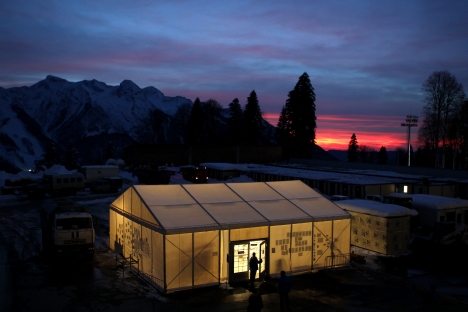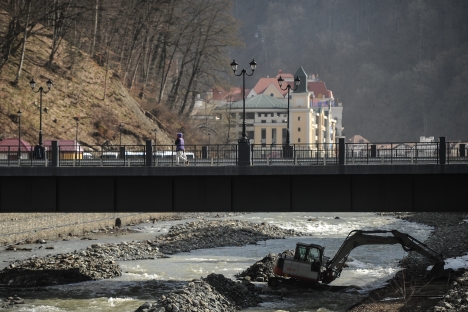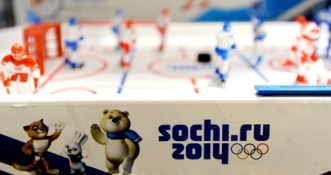Krasnaya Polyana: Reasons to visit before Sochi 2014

Information desk for excursions. Visitors are unlikely to have any problems finding a guide in Krasnaya Polyana. Source: RIA Novosti / Konstantin Chalabov
{***}
About 20 years ago, a trip to Krasnaya Polyana was a challenging and occasionally perilous quest. Options for getting there were severely limited: you could either throw your things into a flimsy green helicopter and hope for the best, or spend 3.5 terror-stricken hours negotiating the winding mountain roads and staring into the abyss below.
Admittedly, the road to Akhshtyrsky Canyon was more or less trouble-free. Still, once you hit the Royal Road — a pathway carved into the rock by Turkish prisoners — any pretenses of a calm veneer went right out the window.

Akhshtyrsky Canyon. Source: RIA Novosti / Konstantin Chalabov
On the right: a near vertical drop, at the bottom of which lay the mangled corpses of unsuspecting Ladas and UAZ cars in the muddy waters of the Mzymta River. On the left: a bombardment of rock fragments, falling like bread crumbs onto the roof of whatever vehicle you were travelling in. Not that leaving the work to professionals made things any easier.
View Larger Map |
If you were making the trip by bus, tour guides would regularly prod at passengers on those treacherous mountain bends with the obligatory joke: “The driver’s just as scared as we all are; that’s why he’s driving with his eyes closed.”
These days, a trip to the mountains is a pleasurable and uncomplicated affair. The menacing mountain roads are a thing of the past; neatly cut tunnels in the limestone rock have reduced the travel time to the city (Sochi) to a mere 30 minutes. Things promise to be even more comfortable by the time the Olympic Games arrive, thanks to the planned monorail that will run from the airport to the old heliport.
With less than a year to go until the Olympics, Krasnaya Polyana looks less and less like a land that time forgot: leafy pathways have turned into highways; bushes have been hacked away to make room for the cable-car stops, which are perched atop tripods that seem to have come straight out of a sci-fi novel; quaint little bungalows have given way to modern chalets with floor-to-ceiling windows.
Why do people go to Krasnaya Polyana? The answer is pretty straightforward — they come for the snow. Russia has its fair share of snow, but only here can the proximity to the sea turn your holiday into a kind of surreal, rollercoaster ride. Imagine the situation: you just went for a swim in the sea and, an hour later, before your hair even has a chance to dry, your skis are crunching fresh, marzipan-textured snow beneath them. Goodbye, nature preserves.
Somber foresters and the occasional meteorologist have been replaced by trendy young Eastern Europeans. The locals were wary at first, but they became used to it eventually.
The Sochi Olympics have been split into the coastal cluster and the mountain cluster. The mountain cluster is one of the oldest places in Krasnaya Polyana — a “Plymouth Rock” of sorts, on which the first wave of migrants crashed. Like all coastal areas, Krasnaya Polyana was originally populated by newcomers. In the 19th century, descendants of Moldovans, Pontic Greeks and Estonians found shelter here.
What exactly is the mountain cluster? The mountain cluster includes the Olympic Biathlon and Ski complexes, the Bobsleigh Track, the Ski Center, the Ski-Jump Complex, as well as the Snowboard Park and the Freestyle Center. Almost all of the facilities are ready for competition — “in the set position,” if you will. Even with a year to go before the opening of the Games, there are plenty of places to have a great time.
A sophisticated cable-car network is strung across the Psekhako Ridge, where you can, if you feel so inclined, travel like a true blueblood prince in a closed carriage with tinted windows. If your tastes are more modest, then you can be whisked away on a plastic chair, legs dangling in the open air above the chasm. If you plan on skiing, then you had better be sure of your abilities beforehand — there are your bog standard green slopes for beginners, as well as a number of black slopes for advanced skiers.
{***}
Where to stay

Krasnaya Polyana. Source: RIA Novosti / Vladimir Astapkovich
Visitors are unlikely to have any problems finding a hotel in Krasnaya Polyana. In fact, it would be more accurate to say that they are literally spoiled with choices.
A single-occupancy room in a 3-star hotel such as the Park Inn by Radisson Rosa Khutor will set guests back around €120–250 ($160–335) per person per night; if you must have the panoramic views of the snowcapped mountain peaks, then a room in the 5-star Grand Hotel Polyana goes for €300–700 ($400–940).
If you are traveling with a group of friends, then your best bet is to rent a villa near the aerial tramways on the banks of the River Laura: a seven-room, two-story hotel costs between €1,000 and €2,500 ($1,345–3,360) per night, depending on the season.
Where to eat
There is also no shortage of restaurants and cafes in Krasnaya Polyana. The best thing to fight those hunger pangs — venison hotpot, wild hog ribs or bear stew, of course! You can sample these exotic dishes at the Vodolei restaurant in Estosadok village (located at 36 Olympic St.), housed in a mysterious cavern-like room with illuminated stalactites hanging from the ceiling.
If you are in the mood for a trout supper, then why not catch it yourself from the small pond in the restaurant’s courtyard?
Be aware that Czar Trout is a local delicacy. You can try the fish, which is specially prepared on a grill with fragrant herbs native to the region, at the Patskha Achishkho in Krasnaya Polyana (at 1 Achishkhovskaya St.) as well. The restaurant is set away from the central street, but this is part of its charm: listening to the swishing mountain lake is much more pleasant than listening to screeching tires.
The alpine café 1144 is something of a cult favorite among locals. Located at Rosa Khutor X-treme Park in Estosadok village (second tier cable car), the name “1144” refers to the café’s elevation height. You need to ride a cable car to get here. The café was made famous by a certain Vladimir Putin, who once ate pancakes with honey here. His portraits hang on the walls like amulets.
What to do

Krasnaya Polyana. Source: Mikhail Mordasov / Focus Pictures
An entire article could be devoted to the topic of summer entertainment in Krasnaya Polyana.
You can go rafting on waters of the “Rage” (this is how the locals refer to the Mzymta River, an allusion to its unruly nature). If you want to go careering recklessly down practically vertical slopes full of overgrown shrubs in an off-road vehicle, then you can give “jeeping” a try. If you prefer a more relaxed pace, then you can take a walk to the Khmelevsky Lakes and see the fascinating tritons that live there. You can also give crossbow shooting a go. The list goes on…
Russian tradition dictates that, in the winter, the thing to do is visit the local bath house (“banya” in Russian). Visitors should know that they have bathing down to a fine art in Krasnaya Polyana.
At the Four Peaks bath house (at 10 Estosadok), a honey, salt or forest-herb rubdown awaits you; at Timeskal (at 94 Zapovednaya St.), the steam room has been replaced by a unique, “black” mud hut, while at Kharakuge (also 94 Zapovednaya St.) you are simply pushed into a giant two-ton water tank hung over a live fire.
What you should take home from Krasnaya Polyana
What should you take home from the heart of the Sochi Olympics?
There will be plenty of souvenirs, you can count on that. If you are after something more homey, you would be well-advised to check out what the old “babushkas” are selling on the street corners: traditional crafts made from local boxwood, warm woolly “dzhuraby” (socks made of goat’s fur, starting at €15) and sweet honey from the Aibga slopes (starting at €10). In terms of charm, these gifts are simply priceless.
If you are lucky, you can try the local raspberry wine (starting at €10) — a homemade brew made with fragrant raspberries. These wines are not mass-produced and are, therefore, very valuable.
About 20 years ago, a trip to Krasnaya Polyana was a challenging and occasionally perilous quest. Options for getting there were severely limited: you could either throw your things into a flimsy green helicopter and hope for the best, or spend 3.5 terror-stricken hours negotiating the winding mountain roads and staring into the abyss below.
Admittedly, the road to Akhshtyrsky Canyon was more or less trouble-free. Still, once you hit the Royal Road — a pathway carved into the rock by Turkish prisoners — any pretenses of a calm veneer went right out the window. On the right: a near vertical drop, at the bottom of which lay the mangled corpses of unsuspecting Ladas and UAZ cars in the muddy waters of the Mzymta River. On the left: a bombardment of rock fragments, falling like bread crumbs onto the roof of whatever vehicle you were travelling in. Not that leaving the work to professionals made things any easier. If you were making the trip by bus, tour guides would regularly prod at passengers on those treacherous mountain bends with the obligatory joke: “The driver’s just as scared as we all are; that’s why he’s driving with his eyes closed.”
These days, a trip to the mountains is a pleasurable and uncomplicated affair. The menacing mountain roads are a thing of the past; neatly cut tunnels in the limestone rock have reduced the travel time to the city (Sochi) to a mere 30 minutes. Things promise to be even more comfortable by the time the Olympic Games arrive, thanks to the planned monorail that will run from the airport to the old heliport.
With less than a year to go until the Olympics, Krasnaya Polyana looks less and less like a land that time forgot: leafy pathways have turned into highways; bushes have been hacked away to make room for the cable-car stops, which are perched atop tripods that seem to have come straight out of a sci-fi novel; quaint little bungalows have given way to modern chalets with floor-to-ceiling windows.
Why do people go to Krasnaya Polyana? The answer is pretty straightforward — they come for the snow. Russia has its fair share of snow, but only here can the proximity to the sea turn your holiday into a kind of surreal, rollercoaster ride. Imagine the situation: you just went for a swim in the sea and, an hour later, before your hair even has a chance to dry, your skis are crunching fresh, marzipan-textured snow beneath them. Goodbye, nature preserves. Somber foresters and the occasional meteorologist have been replaced by trendy young Eastern Europeans. The locals were wary at first, but they became used to it eventually.
The Sochi Olympics have been split into the coastal cluster and the mountain cluster. The mountain cluster is one of the oldest places in Krasnaya Polyana — a “Plymouth Rock” of sorts, on which the first wave of migrants crashed. Like all coastal areas, Krasnaya Polyana was originally populated by newcomers. In the 19th century, descendants of Moldovans, Pontic Greeks and Estonians found shelter here.
What exactly is the mountain cluster? The mountain cluster includes the Olympic Biathlon and Ski complexes, the Bobsleigh Track, the Ski Center, the Ski-Jump Complex, as well as the Snowboard Park and the Freestyle Center. Almost all of the facilities are ready for competition — “in the set position,” if you will. Even with a year to go before the opening of the Games, there are plenty of places to have a great time. A sophisticated cable-car network is strung across the Psekhako Ridge, where you can, if you feel so inclined, travel like a true blueblood prince in a closed carriage with tinted windows. If your tastes are more modest, then you can be whisked away on a plastic chair, legs dangling in the open air above the chasm. If you plan on skiing, then you had better be sure of your abilities beforehand — there are your bog standard green slopes for beginners, as well as a number of black slopes for advanced skiers.
Where to stay
Visitors are unlikely to have any problems finding a hotel in Krasnaya Polyana. In fact, it would be more accurate to say that they are literally spoiled with choices. A single-occupancy room in a 3-star hotel such as the Park Inn by Radisson Rosa Khutor will set guests back around €120–250 ($160–335) per person per night; if you must have the panoramic views of the snowcapped mountain peaks, then a room in the 5-star Grand Hotel Polyana goes for €300–700 ($400–940). If you are traveling with a group of friends, then your best bet is to rent a villa near the aerial tramways on the banks of the River Laura: a seven-room, two-story hotel costs between €1,000 and €2,500 ($1,345–3,360) per night, depending on the season.
Where to eat
There is also no shortage of restaurants and cafes in Krasnaya Polyana. The best thing to fight those hunger pangs — venison hotpot, wild hog ribs or bear stew, of course! You can sample these exotic dishes at the Vodolei restaurant in Estosadok village (located at 36 Olympic St.), housed in a mysterious cavern-like room with illuminated stalactites hanging from the ceiling. If you are in the mood for a trout supper, then why not catch it yourself from the small pond in the restaurant’s courtyard?
Be aware that Czar Trout is a local delicacy. You can try the fish, which is specially prepared on a grill with fragrant herbs native to the region, at the Patskha Achishkho in Krasnaya Polyana (at 1 Achishkhovskaya St.) as well. The restaurant is set away from the central street, but this is part of its charm: listening to the swishing mountain lake is much more pleasant than listening to screeching tires.
The alpine café 1144 is something of a cult favorite among locals. Located at Rosa Khutor X-treme Park in Estosadok village (second tier cable car), the name “1144” refers to the café’s elevation height. You need to ride a cable car to get here. The café was made famous by a certain Vladimir Putin, who once ate pancakes with honey here. His portraits hang on the walls like amulets.
What to do
An entire article could be devoted to the topic of summer entertainment in Krasnaya Polyana: you can go rafting on waters of the “Rage” (this is how the locals refer to the Mzymta River, an allusion to its unruly nature); if you want to go careering recklessly down practically vertical slopes full of overgrown shrubs in an off-road vehicle, then you can give “jeeping” a try; if you prefer a more relaxed pace, then you can take a walk to the Khmelevsky Lakes and see the fascinating tritons that live there; you can also give crossbow shooting a go. The list goes on…
Russian tradition dictates that, in the winter, the thing to do is visit the local bath house (“banya” in Russian). Visitors should know that they have bathing down to a fine art in Krasnaya Polyana. At the Four Peaks bath house (at 10 Estosadok), a honey, salt or forest-herb rubdown awaits you; at Timeskal (at 94 Zapovednaya St.), the steam room has been replaced by a unique, “black” mud hut, while at Kharakuge (also 94 Zapovednaya St.) you are simply pushed into a giant two-ton water tank hung over a live fire.
What you should take home from Krasnaya Polyana
What should you take home from the heart of the Sochi Olympics? There will be plenty of souvenirs, you can count on that. If you are after something more homey, you would be well-advised to check out what the old “babushkas” are selling on the street corners: traditional crafts made from local boxwood, warm woolly “dzhuraby”(socks made of goat’s fur, starting at €15) and sweet honey from the Aibga slopes (starting at €10). In terms of charm, these gifts are simply priceless. If you are lucky, you can try the local raspberry wine (starting at €10) — a homemade brew made with fragrant raspberries. These wines are not mass-produced and are, therefore, very valuable.
All rights reserved by Rossiyskaya Gazeta.
Subscribe
to our newsletter!
Get the week's best stories straight to your inbox
